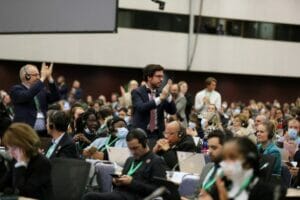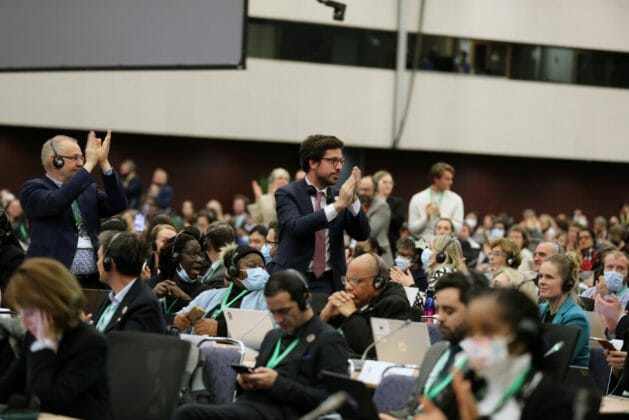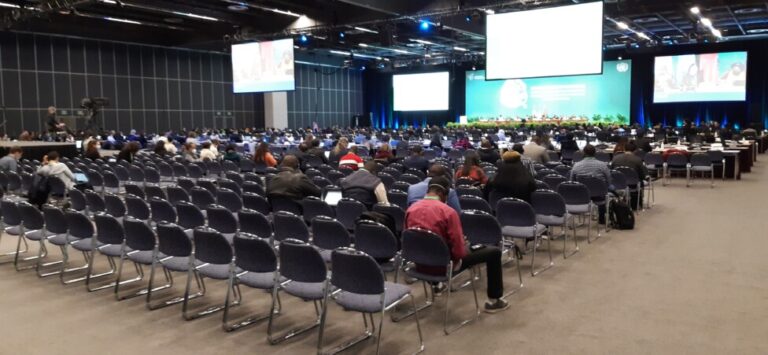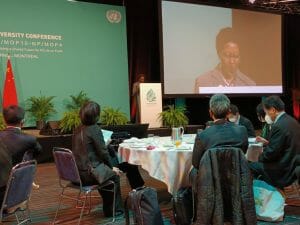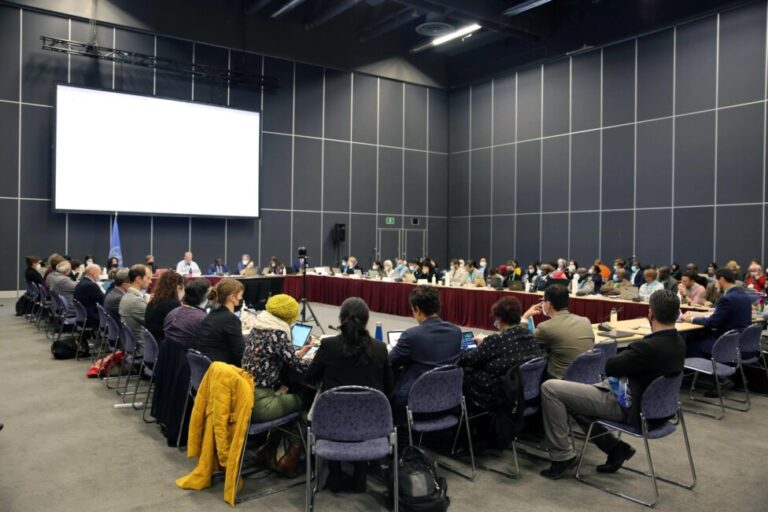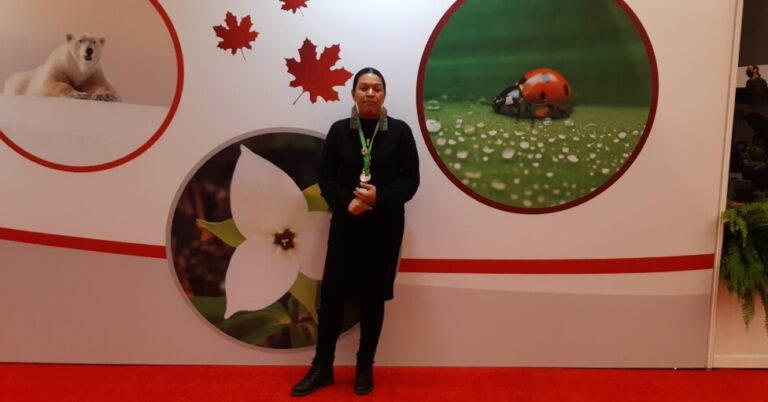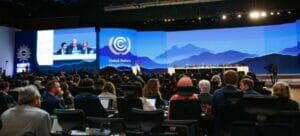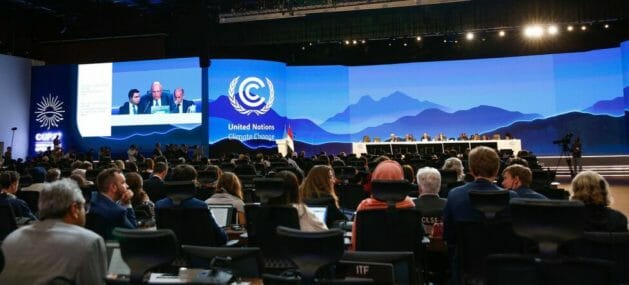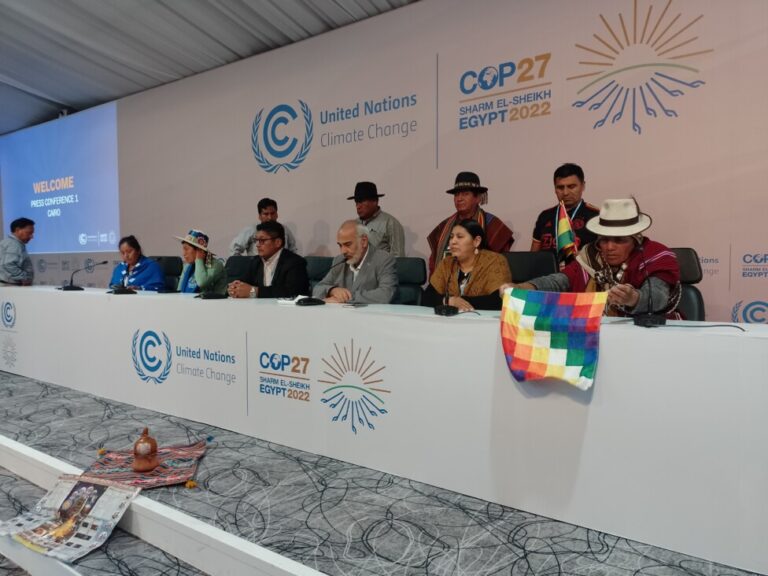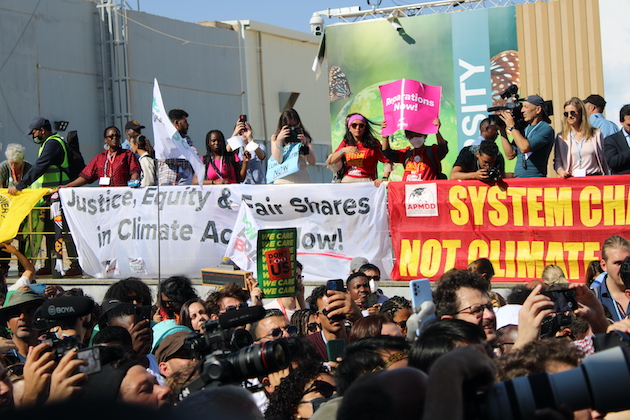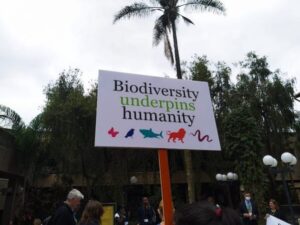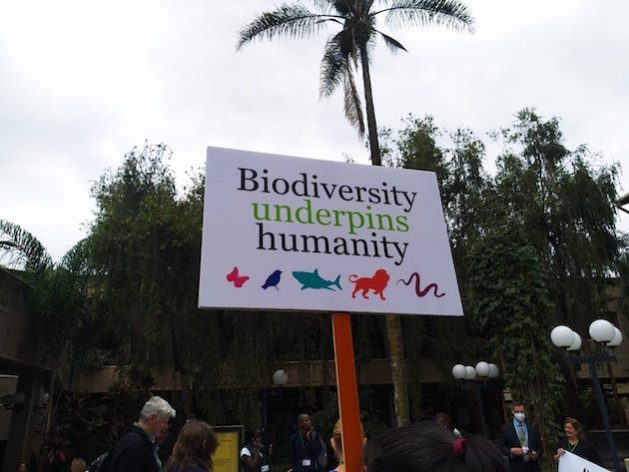

From climate change to child marriage, education is seen as the solution. ECW Director Yasmine Sherif protests early marriage with young delegates at the Education Cannot Wait Conference held in Geneva. Credit: ECW
By Joyce Chimbi
GENEVA & NAIROBI, Feb 17 2023 (IPS)
From southern Ethiopia to northern Kenya and Somalia, the most severe drought in the last 40 years is unfolding. It is simply too hot to go to school on an empty stomach, and close to 3 million children are out of school, with an additional 4 million at risk of dropping out entirely across the Horn of Africa.
Further afield, months after unprecedented floods and landslides ravaged Pakistan, villages remain underwater, and millions of children still need lifesaving support. More recently, while children were sleeping, a most devastating earthquake intruded, and an estimated 2.5 million children in Syria and 4.6 million children in Turkey were affected.
Today, child delegates from Nigeria and Colombia told the world that climate change is ruining their childhood and the world must act now, for 222 million dreams are at stake. They were speaking at the Education Cannot Wait High-Level Financing Conference held in Geneva.

Nafisa from Nigeria reminded delegates at the Education Cannot Wait High-Level Financing Conference held in Geneva that the climate emergency is a child’s rights issue. Credit: ECW
“I am a girl champion with Save the Children and a member of the children’s parliament in Nigeria. Children are least responsible for the climate crisis, yet we bear the heaviest burden of its impact, now and in the future. Climate emergency is a child’s rights crisis, and suffering wears the face of a child,” said Nafisa.
In the spirit of listening to the most affected, most at risk, Pedro further spoke about Colombia’s vulnerability to climate change and the impact on children, and more so those in indigenous communities and those living with a disability, such as his 13-year-old cousin.
Pedro and Nafisa stressed that children must play a central role in responding to the climate crisis in every corner of the world. They said climate change affects education, and in turn, education has an important role.
This particular session was organized in partnership with the Geneva Global Hub for Education in Emergencies, Save the Children, and Plan International, in the backdrop of the first-ever High-Level Financing Conference organized in close collaboration with the Governments of Colombia, Germany, Niger, Norway, and South Sudan, ECW and Switzerland.
Birgitte Lange, CEO of Save the Children Norway, stressed that climate change is not only a threat to the future, “for the world’s 2.4 billion children, the climate crisis is a global emergency crisis today that is disrupting children and their education. Climate change contributes to, increases, and deepens the existing crisis of which children are carrying the burden.
“Last year, Save the Children held our biggest-ever dialogue, where we heard from at least 54,000 children in 41 countries around the world. They shared their thoughts on climate change and its consequences for them. Keeping children in school amidst a climate crisis is critical to the children’s well-being and their learning. Education plays a lifesaving role.”
Rana Tanveer Hussain, Federal Minister for Education and Professional Training in Pakistan, spoke of the severe impact of the floods on the country’s education system, “more than 34,000 public education institutions have been damaged or destroyed. At least 2.6 million students are affected. As many as 1 million children are at risk of dropping out of school altogether.
“During this crisis, ECW quickly came forward with great support, extending a grant of USD 5 million through the First Emergency Response Program in the floods-affected districts in September and October 2022, targeting 19,000 children thus far. In addition, ECW multiyear resilience program has also been leveraged to contribute to these great efforts. But the need is still great.”
Gregorius Yoris, a young leader representing Youth for Education in Emergencies in Indonesia, said despite children being at the forefront of the climate crisis, they have been furthest left behind in finding solutions to climate change.
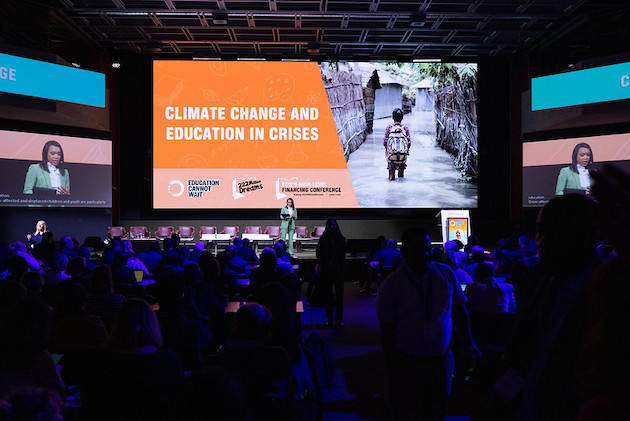
Folly Bah Thibault, broadcast journalist, Al Jazeera, and Founder and President, Elle Ira A L’Ecole Foundation Kesso Bah moderated the session on climate change in which child delegates told how children are being left furthest behind in the climate crisis. Credit: ECW
With one billion children, or nearly half of the world’s children living in countries at extremely high risk of climate change and environmental hazards, Dr Heike Kuhn, Head of Division, Education at the Federal Ministry for Economic Cooperation and Development in Germany, told participants it is time to raise climate resilient children.
“Weather-related disasters are growing, and young people are the most affected; we need three things in place: climate resilient schools, climate resilient teachers, and climate resilient students. We need climate-smart schools to stay safe when disaster strikes,” she explained.
“We must never forget about the teachers, for they must be agents of change, and teach children to use resources such as water and energy in a sustainable way. Children must also be taught how to behave during extreme weather changes such as earthquakes without leaving behind the most vulnerable children.”
As curtains fell on the landmark two-day conference, Yasmine Sherif, the Director of Education Cannot Wait, told participants, “The greatest feeling comes from the fact that all ECW’s stakeholders are here and we have raised these resources together, governments, civil society, UN agencies, private sector, Foundations.
“When I watched the panels and the engagements, I felt that everyone has that sense of ownership. Education Cannot Wait is yours. The success of this conference is a historic milestone for education in emergencies and protracted crises.”
In all, 17 donors announced pledges to ECW, including five contributions from new donors – a historic milestone for education in emergencies and protracted crises and ECW. Just over one month into the multilateral Fund’s new 2023-2026 Strategic Plan, these landmark commitments already amount to more than half of the USD 1.5 billion required to deliver on the Fund’s four-year Strategic Plan.
On the way forward, Sherif said ECW is already up and running, but with the additional USD 826 million, the Fund was getting a big leap forward toward the 20 million children and adolescents that will be supported with holistic child-centered education. This is in line with the new Strategic Plan, whose top priorities include localization, working with local organizations at grassroots levels, youths, and getting the children involved as well.
“We can no longer look at climate-induced disasters and education in silos. Conflict creates disruptions in education, so does climate-induced disasters and then the destiny of children and adolescents having to flee their home countries as refugees or forcefully displaced in-country,” she emphasized.
“Most of all, as we have seen in Afghanistan and across the globe, the right for every girl to access a quality education. And we are moving already, and that is where we are going from here. Thanks to the great contribution in the capital of humanitarian settings, we are bringing the development sector of education to those left furthest behind. Thank you, Switzerland, for hosting us.”
IPS UN Bureau Report

